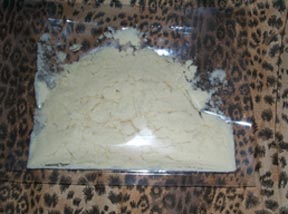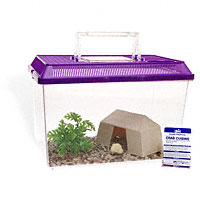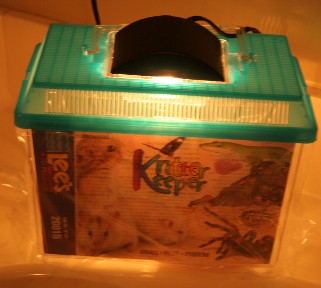Rejected Joeys
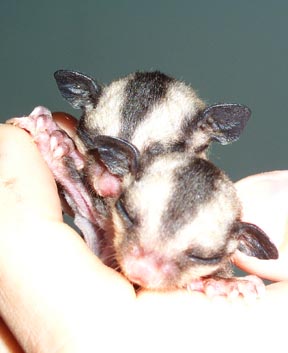
1. The Esbilac Milk Replacer (1st week)for Puppies OR Wombaroo Possum Milk Stage 2
2. Feeding Tube and 2 Syringes
3. Kritter Keeper With Light (if this is used Saran to cover the top is not necessary)
4. Themometer for Kritter Keeper
5. Heating Pad or Heating Element for outside Kritter Keeper
6. Glass of water to put inside incubator
7. Small Pouch with No clips or strings
8. Saran wrap to cover the outside of Kritter Keeper if Light is not purchased
9. Glass of Water (remove after three weeks old)
10. Pedialyte(grocery or drug store) (to be mixed with powdered milk)
|
TOANDFRO PRODUCTS
|
||
|
Large
Small |
Wombaroo Marsupial Milk (Large Size now in plastic bottle instead of box picture coming soon) 2 SIZES 125g net for $21.50 and New Smaller size 2 ounces $4.99 |
Large
Small
|
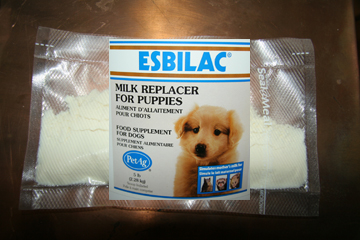 |
Esbilac 2 Ounce Sample Save a life! Find everything you need to nurse orphaned, abandoned or rejected puppies. Contains soy-free protein from four high-quality protein sources.Esbilac has been formulated to closely match mother's milk in protein, fat, and carbohydrates. Esbilac is fortified with essential vitamins and minerals to keep your puppy growing stronger every day. Can also be fed to rabbits and ferrets. $3.50 |
$3.50 Out of Stock |
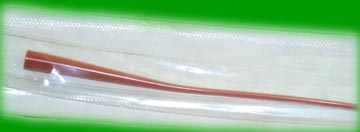 |
This is a French Catheter that fits right on to a U-100 Syringe. It is the size of the mother's nipple and is easy to control as the joey latches right on the tip $2.80 |
|
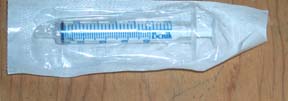 |
3cc Syringe $2.00 Would suggest purchasing two
|
$2.00
|
|
Rectanglular Medium Kritter Keepers™ have self-locking lids with hinged viewer/feeder windows, an airline access hole ad an attachment hole Size: 11-3/4"Long x 7-3/4"Wide x 8"High $9.99 |
$9.99 |
|
|
|
Kritter Light Simply pop out the clear viewer/feeder (on top of the Kritter Keeper) and replace with Lees Kritter Light $12.00 |
$12.00 |
|
Keep those babies warm! Solid state Nichrome heating element. Permanently adheres to your terrarium, forming a solid bond for better heat transfer. Comes complete with 8 page instruction booklet. Works like a heating pad, but made for animals.
5" x 4" $12.50 |
$12.50
|
|
|
|
Energy Savers Unlimited Battery Digital Thermometer for Terrariums / Aquariums is ideal for aquariums and terrariums. Readings in 0.1 degrees Fahrenheit or Celsius. Temperature range -10 degrees F to 140 degrees F (-23 degrees C to 60 degrees C). Mounting suction cups & battery included with a 39 inch long temperature probe cord. Keep your Joeys at the Right Temperature $9.66
|
$9.66 |
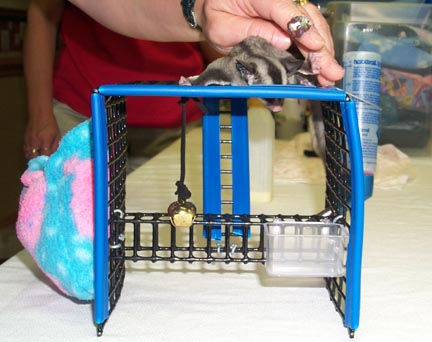 |
Pegs Critters has this cute little jungle gym for rejected joeys. Contact Peg for details. |
|
To
read our philosophy on saving a rejected joey please go here.
If you find your joey laying on the bottom of the cage cold or hanging on the side crying, there is a good possibility it has either fallen out, or been rejected. Rejection is a term that is widely used by many sugar glider owners and has a connotation of being "unwanted". The baby found on the floor is not necessarily an unwanted joey, just a hungry one. It is better to be prepared ahead of time if you have in your care, a glider that you have purchased that has done this before. Don't think because you are giving it a better diet that your female won't be a repeat offender. There are several reasons besides diet that a sugar glider will do this. It is my purpose here to go through some of these behaviors, and hopefully that behavior can be corrected, changed, and more little lives will be saved.
There are several reasons a female will reject a joey, but the main one is a psychological one. She is saying, "I can't do this", in other words, "stress". Gliders are stress oriented animals, and the high stressed, nervous gliders are more succeptible to rejection of a joey. This is normally do to inexperinece on the part of the male and female. The male plays an important roll throughout the entire pregnancy, by making her feel comfortable during playtime, to babysitting and keeping the joeys warm. If you are having trouble with a female rejecting, and would like to have joeys, switch her partner to a more experienced male. If you are not willing to do this, have your male neutered! It is far too stressful on your female to repeat this process over and over and you could end up losing her trying to make it work. Here is a story from a little mother's perspective which will help you better understand the psychological aspects of rearing and caring for a joey or joeys.
| "I am so afraid to come out because my joeys will be hurt. I don't know what will be out there tonight. I am safe in this warm pouch with them, but I am also hungry and must get food soon. I am getting too large to keep them stuffed in the pouch and if they are hanging out, one might be susceptible to prey on the outside. I will keep them with me for a few days (three) until they grow a little hair. That way, they won't be quite so cold when I leave them. Papa will keep them warm while I am gone and I can go out and run a few laps in my wheel and have a snack here and there. I should have enough time to get enough nourishment to give back to my babies. If I don't get enough, someone has to suffer. I am back to the nesting area and realize I don't have enough milk for the two joeys. It will take at least an hour before this food turns into milk. Why was I fed so late tonight? The babies are crying. Daddy is out right now eating and I need to go out again, but cannot leave them here alone. I guess I will have to wait. Ouch, the joeys have teeth and with a dry nipple, that hurts. In my defense, I nip one on the face. Oh no, I have hurt it and now my joey doesn't feel so good. Whew, Dad's back and I can get a bite to eat. When I get back the one joey that I nipped is asleep. He needs to wake up because my babies feed about every ten minutes right now. Oh no, he has slept through a feeding, and is weaker. He needs little strong jaws to latch on to my teet, so what do I do??? He also lies beside me and can't smell my milk. I think he is losing his sense of smell. I am sad. My ears are down because my baby will die. He has crawled out of my nest looking for food. I wish he would come back and nurse, but for some reason he can't smell my milk and is looking elsewhere for food. I hope someone finds him before it is too late. I am stressed now worring about him. I go out several times running around the cage worrying about him cause he is going to die. No one came and got him and he is dead. I need to clean up his remains so no bad animal will come near my other baby. The other baby I have is getting hungry too. I better see about him. Oh no, the same thing is happening to him, he missed a feeding cause I was out seeing about the dead baby. I can't handle this." |
What a sad story, but it happens every day with little mamas. How can we avoid this?
1)There are several ways, but let me begin with the first and most important, the diet. A breeding female needs almost twice a much protein as a non breeding female or male. When you plan on breeding your female, make sure that she is being supplented with a dry food that contains about 25% or more protein. Dry food, in addition to mealworms or crickets will help decrease the chance of a rejected little one. At ToandFro we recommend Mazuri and PetPro Breeders Formula. We purchase our mealworms and crickets from Herpfood.com. Sprinkling Marsupial milk or Booster Powder over their food helps while rearing joeys because it ads protein and calories to the milk.
2)The second issue is the nesting place. If you have a repeat offender and you are a pouch user, switch to a nesting box like the chinchilla boxes. We also sell a nesting box for birds that works well that you can see into the box without disturbing mama, daddy and joeys. If you are using a pouch or box, make sure there are extra pieces of fleece to help them feel more secure and protected. They will tend to cover their heads with this fleece to protect themselves.
3)Handling: Have only one person checking the pouch or box. Checking less is better as it makes the mom more stressed. When handling the joeys, wash hands and have only one person handle them until you know they are out of the rejection zone (normally two weeks). Only handle animals at feeding time during the first week to mimimize their stress. Try to avoid waking them for "show and tell" to your friends, and always hold animals in a pouch so that they feel secure. This includes mama and babies. Taking the babies away from mama can be stressful to her, so limit your times to 10 minutes three times a day, when they are three days old. Any longer than this, they will miss the next feeding and can be succeseptible to becoming too weak to feed. If you are supplementing, please leave them with Mom and Dad. Mom has the best milk for her joeys.
4)If you female rejects two pregnancies in a row, you might want to try her with an experienced male. I for one, don't like to change a glider around, but sometimes it actually makes a female more self assured to have a male that knows what to do. Normally, the male comes out to eat first because the joeys are still attached. This allows him to babysit later on. An experienced male will stay with the joeys while the female eats. When the female sees that he does not come out to play with her as he usually does, she runs back to the pouch or nesting area to check on him to see if he will come out. Since he will not, she comes and sits with him and the joeys latch on again to her which is what needs to happen so that she can come back to her responsibilities of motherhood.
5. Mama's in heat: Sometimes we need just to supplement during this time until mom takes back over. A female's colostrum comes in within the first 72 hours and the colostrum contains antibioties for the joey. Gliders are unlike us. We get colustrum in the wound and have enough antibioties to last us as babies for 6 months. Gliders receive their first colostrum within the first 72 hours. Many rejections happen during that time. Mama can become engourged as the milk comes in making it hard for the baby to latch on. When a mama goes in heat which is sometimes between day three and 7, the milk changes in taste and the joey doesn't want to feed as often. It is our jobs to get the joeys over the hump. Most joeys don't seem to mind the change in taste. Please watch for Parent's mating. Mother does not get as much food on that night and you might want to drop a couple of mealworms in the pouch and a grape and apple slice. Sometimes the mother doesn't have a chance to eat until 4:00am and many times the food is already gone if there are multi gliders in the cage.
If you have done these four things and haven't had success, you might want to have your male neutered. Your female will live a long happy life having a companion without the stress of losing their joeys.
For one year I let a female continue to breed and reject to study the behavior and patterns of parents and joey in rejected situations. These situations below may not be exactly like yours. There are several reasons why a female chooses to reject joeys. The most widely publicized reason is because something is wrong with the joey. It is my belief that nine out of ten times this is not true. Occasionally, the mother is ill and cannot feed and this is a reason too for rejection.
Below are Archive Stories from my Experiences and Others with Rejected joeys
I had a friend who recently called me and asked my advice about a joey that was still in the pouch with Papa, and Mama was running around the cage like crazy. This was a rare case because there were still two lumps in her pouch even with the baby out. She came to the conclusion that perhaps she was carrying triplets. I referred her to the instructions of a rejected joey which was clearly laid out in Caroline MacPherson's book "Sugar Gliders: Complete Pet Owner's Manual", but not knowing for sure if it had been rejected, she decided to try and see if the baby would crawl back into the pouch. That is exactly what happened. She held Mama in one hand and baby in the other with palms face up and the baby crawled back inside. This was an unusual case, but it can happen. A mama can reject a baby because she is too young to be a mama (stressed about a first baby - who isn't?) or something is wrong with the baby, or in my friend's case the baby got pushed out for lack of room. If you are fortunate enough to rescue the joey in time, you have a chance to save the little one. If the baby is still pink with no gray fur, you could possibly lose it. It is not your fault, because it is hard to achieve the exact temperature that the joey needs to maintain.
JULES:
I owned a glider named Jules. She was a joey when I purchased her at 7 weeks old from a large breeder in Texas. Jules was a tame hyper glider. She never stopped running in her wheel. I believe that the wheel is a stress reliever for a lot of gliders. I would put food in her cage and she would stop in the wheel look at it and then keep running. Jules had two pregnancies and was successful with both. She was a small glider weighing about 70 grams. When she was almost two years old, she had two joeys - rejected one and I supplemented it twice a day. Everytime I was late on a feeding, I would find the joey on the floor of the cage or climbing up the sides looking for food. As long as I didn't miss a feeding, or as long as I wasn't late with one, Jules would do the rest. If I missed a feeding, the babies face would be injured. What mothers do is bite the babies face when they are trying to nurse. Sometimes the hair around the wound falls out and the wound looks larger than it actually is. There was always one large strong joey and one weak one. The large one would be exceptionally strong and stout. This behavior of rejection puzzled me to the point where I watched and studied the behavior of Jules. When we first got Jules, she was bonded with my daughter. We added Jasper, an alpha male with her and as the smell became greater with the male, my daughter played with Jules, less and less. That is when Jules began to reject. I am not saying that bonded gliders will not reject, I am saying that a glider who felt loved and secured, but now didn't feel that way, also lost confidence in Joey rearing. Jules also became more nervous and skiddish. She never crabbed and I had no problem retreaving the joeys, but she never wanted me to see her tummy or be vunerable. I was never able to see her tummy on the side of the cage and every time she was on her back in the pouch, she would flip over as I peered inside the pouch. When she was 2.5 she had two boys, Damien and Sampson and of course Sampson was the strong one. She would not allow Damien to nurse at all past 5 days. I supplemented his all feedings but continued to let him live with Mom and Dad for the duration of the nursing period. Sampson, weaned himself at 7 weeks and when he did a very strange thing happened. Jules allowed Damien to nurse again for two more weeks.That is when I knew in Jules mind that she felt she could not nurse two joeys, but only one. From that point on, everytime she had two joeys, one was rejected. In the last year I had her before I sold her to a friend named Peggy, both joeys were rejected. Now these joeys didn't try to suck on her, they just lay beside her in the pouch. When the joeys were four days old, they died and the next day, took Jules to the vet and he put her under to examine the nipples. They were full of white creamy milk. I knew then that her production of milk was plenty ample for two sugar gliders and it had to have been a pschological problem for her. With her last joey, I left her with Jules for 10 weeks and Jules got down to 65 grams. She had one set of twins after that and she rejected one, had a single joey and was great with her, and never got pregnant again. For six months she remained without joeys and every month, he continued to breed with her. I believe that Jules was aborting her joeys by killing them on their way to the pouch). Jules resistance was down after letting the joey suckle for an extended time.
It is best to be prepared and there are a few things you can do. These are a list of things you can have on hand just in case it happens.
First, make sure you are calm. A glider can sense your stress. You have a choice at this point if you are going to just supplement (feed two to four times a day) and let Mom do the rest, or take the baby out permanently and feed round the clock. I will say that I have had twice as much success stories of the babies being supplemented than being completely removed. I would only remove a joey if the mother has done harm or severe bodily damage to the joey. I have removed two joeys in the past and in one case I thought maybe the joey was ill. In the other case, it was in my first year of breeding and that is all I knew. In about 99% of the cases, I leave baby with mother. They have a much better chance at life this way. For some reason, Mothers are concerned with their own health first and if they think for any reason they will not survive because of a nursing joey, they will not let the joey eat to save themselves. As long as you keep the joey healthy, Mom is pretty satisfied with herself and keeps the baby going too. Make sure that your hands are washed each time you handle the joey. Place the joey back in immediately after feeding! Don't worry about bonding with the joey at this time. Your joey will think of you as its second mother very soon. When you realize you are going to have to handfeed, it is very rough for the first three days. A joey only knows how to suck, not lick for at least the first three days. You will have to teach it your way of feeding, which is different than moms. After years of feeding the joeys through a syringe, I now feel it is easier, particularly for the joey less than 5 days, to feed a new and different way. I have had 100% success with feeding joeys who have been rejected on day one. The average person does not recognize the rejection signs. By the time they pull the joey to feed, the joey is cold and lethargic. Feeding them out of a syringe and a French Cathetar is the last thing they want at this point. A warm hand, cupped and filled with warm milk, forces them to be on top sucking downward in the same position they are in with mom on their backs and they lay on top of her. For a joey that cannot lick yet, this is ideal. I love this way of feeding so much, I won't go back to the other way of feeding. The most wonderful thing about this feeding is that it only takes 5 minutes to feed per joey. The head will have to be regulated to keep it from bobbing up and down in the milk,by holding your thumb under their chest and your forefinger on top of their head. The milk is poured into the palm of the left hand using a French Cathetar and Syringe. This feeding usually takes five minutes! This limits them to time away from mom and dad which is less stress on the whole group. This type of feeding can only be done with milk, not baby BML. You can easily see the milk in their tummies when you lift them up. They will stop eating when they are full and their bellies will be rounded. By supplementing, you can put the joeys back in with mom and dad and they will clean and groom them, keeping them at the perfect body temperature which is so hard for us to achieve. They will continue to get the best possible milk (from mom) and eventually she could become comfortable enough to nurse her full time again which is a gradual process, but has been done successfully. You will know if mom is taking over the job if you try and feed them and they eat less because they are too full and bellies are rounded even when you take them out for feeding.
Movie above of joey 5 days old. Second Movieto the right ofthe first movie is of month old joey. If they have no head control or under five days old, feed them like in the movie on the right where you regulate the bobbing of the head, being careful not to get milk in nose..
Setting up a Nursing Area:
This is to be done only if the joey has been injured or the joey or parents are ill.
Put the heating pad or a regular heating pad under the Pet carrier (see below the Kritter Keeper)and put on low (you will have to test it). Before you put the joey in there, feel with your hand to see if its not too hot. Lay the joey on a soft cloth such as a diaper or soft fleece in the plastic or glass aquarium. I also recommend just laying a pouch in the bottom the the Plastic Kritter Keeper. Place two glasses of warm water in the corners of the aquarium.Cover the top of the aquarium top with plastic wrap leaving airholes (punched holes) exposed on the sides. You are trying to create a warm and humid environment much like the inside of mama's pouch. When the water becomes tepid, refill with warm water. It is important to warm the joey before feeding. You also might want to put a towel in the dryer and get it nice and warm to warm the joey up. Make sure the head on the joey is covered as much of the heat is lost on top of the head. In a few minutes the joey will warm up and you should immediately offer it the Esbilac milk or Marsupial milk mixed with the Baby BML if the joey is 5 days or older. If younger than five days, you might want to try our new method of feeding in the palm. The Baby BML is exactly like the BML recipe minus the wheat germ.. Before you handle the joey, make sure your own hands are very warm. Mix a scoop of the Esbilac powder or Wombaroo to three scoops of water. Mix well one 1/2 Milk to two parts Baby BML. If you think the joey has been rejected for several hours already, you might want to mix Pedialyte (grocery store) instead of water to keep the joey from dehydrating, or you may want to offer the Pedialyte first before you offer the Baby BML/Wombaroo mixture. Warm a small portion of the milk/BML and Pour into a 3cc syringe. Place a feeding tube over the syringe with a feeding catheter attached and clip off the feeding tube to about 2-3 inches so that you can manage the feeding aparatus. Feed the joey one small drop by placing it on the babies mouth, being careful not to squirt into the nostrils or directly down the throat. If the joey is pink, feed on demand or every two hours which ever comes first. If the joey is fully furred (2-3 weeks old), feed every three to four hours increasing the amount of milk as needed. Babies tend to get a little sleepy when their bellies get a little full. Don't force feed the joey. Lay it down in the warm aquarium and you might hear it crying again in just a few minutes. As the baby matures, offer it foods of fruits and vegetables, and regular BML which have been mixed in a blender.
If a baby has diarrhea, mix Pedialyte in with the powder every other feeding. Joeys can have stress bacteria too just from the change of food. Make sure the baby is urinating and defecating by gently stroking the area between the base of the tail and the cloaca with a warm wet swab or Q-Tip after every meal or when you first get it up. If you are just supplementing (2-3 times a day) and letting Mom do the rest,watch to see if Mom or Dad are doing their job to clean the baby up(making sure it goes to the bathroom). Every time you get the joey out, check the joey to make sure that the stomach is not bloated. If it is bloated, wait two hours before feeding again.You will probably need to check the bloating tummy until the joey is 5 weeks old or until they are going on their own. When the babies eyes open you will know that it is about 1 to 2 weeks out of pouch. Feel free to email me with any questions you may have concerning this and I will help you as best as I know how.
Some ideas mentioned above come from Caroline MacPhearson's Book, "Caroline MacPhersonSugar Gliders : Complete Pet Owner's Manual". This book is a wonderful book for resources and every owner should have a copy.
Home-Links-InfoPouch-MeetTheFamily
